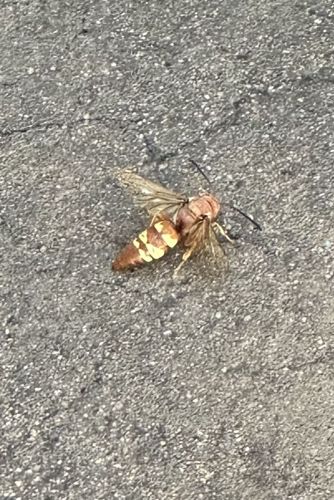Eastern Cicada Killer Wasp
Scientific Name: Sphecius speciosus
Order & Family: Order: Hymenoptera, Family: Crabronidae
Size: Large wasps, typically ranging from 1 to 2 inches (2.5 to 5 cm) in length, with females being larger than males.

Natural Habitat
Cicada killers prefer loose sandy soil or well-drained loamy soil to dig their burrows. They are commonly found in lawns, gardens, parks, and along the edges of wooded areas where cicadas are abundant. They are often seen near trees where cicadas are active.
Diet & Feeding
Adult cicada killers primarily feed on nectar and plant sap. The larvae, however, feed on paralyzed cicadas that the female wasp provides for them in underground burrows.
Behavior Patterns
Cicada killers are solitary wasps, meaning they do not live in colonies like social wasps (e.g., hornets, yellow jackets). The females dig burrows in the soil, often in sandy or loose dirt, where they lay their eggs. They paralyze cicadas with their sting and carry them back to their burrows to provision their larvae. Males are territorial and will often fly around their chosen territory to defend it from other males, but they do not sting. Adults are active during the summer months when cicadas are present.
Risks & Benefits
Risks: Female cicada killers have a sting, but they are generally not aggressive towards humans unless directly provoked or handled. Stings are painful but typically not dangerous unless a person is allergic. Males do not possess a stinger. Benefits: Cicada killers help control cicada populations, which can sometimes be damaging to trees in large numbers. They also contribute to aeration of the soil through their burrowing activities.
Identified on: 8/12/2025